JURI 1107: Analyzing Offer, Acceptance, and IP Law Case Studies
VerifiedAdded on 2023/06/14
|8
|1096
|423
Case Study
AI Summary
This case study delves into various legal concepts including offer and acceptance, copyright infringement, and sexual harassment within the framework of Canadian law. The first scenario examines whether a woman breached copyright law by posting a photo of a painting she purchased. The analysis concludes that she did not, as she owned the painting and its rights. The second scenario focuses on copyright infringement, where a brother stole his sibling's play concept and profited from it, leading to a clear violation of copyright law. The final scenario addresses sexual harassment, analyzing repeated unwanted date requests as a form of hostile environment harassment under Canadian criminal code. Desklib provides a platform for students to access similar solved assignments and past papers for enhanced learning.
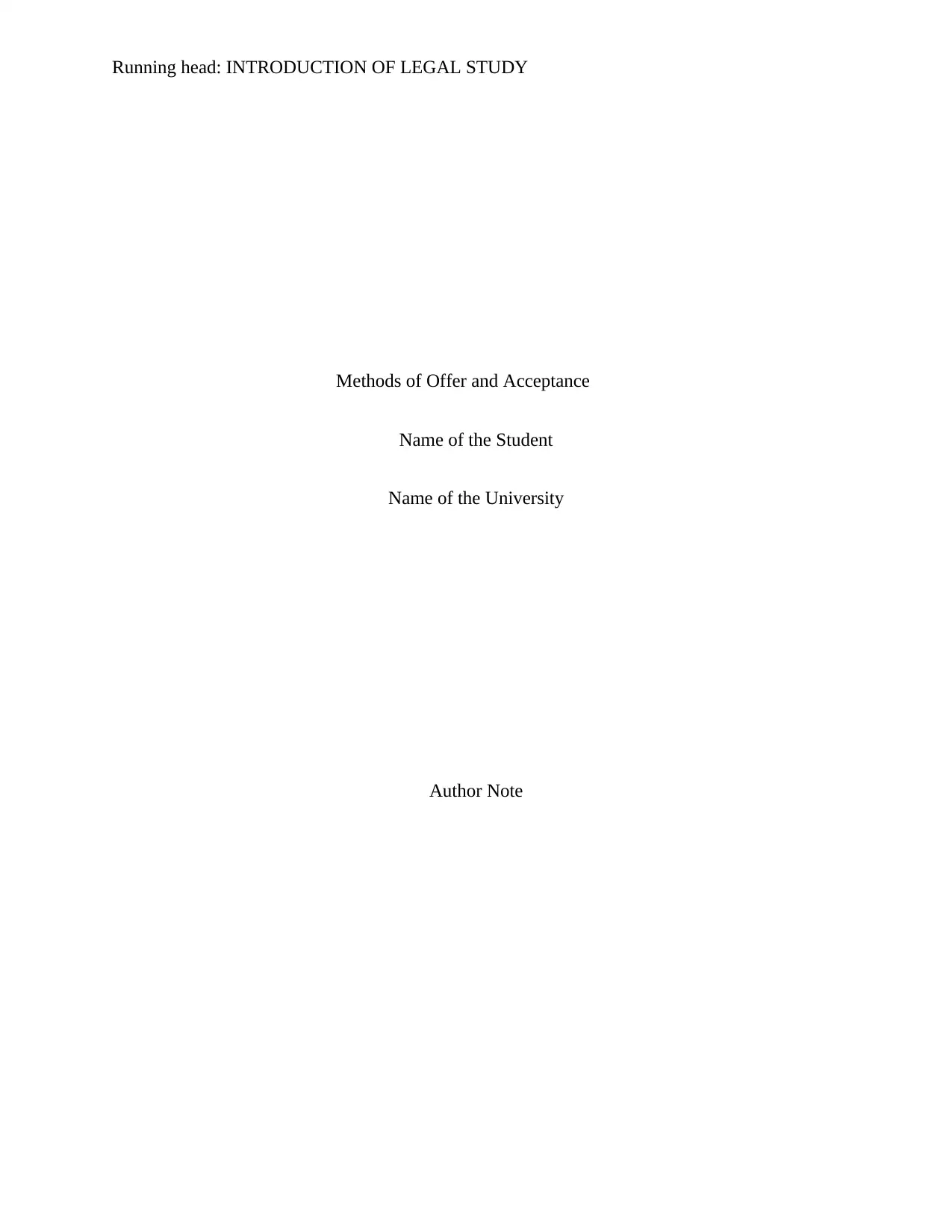
Running head: INTRODUCTION OF LEGAL STUDY
Methods of Offer and Acceptance
Name of the Student
Name of the University
Author Note
Methods of Offer and Acceptance
Name of the Student
Name of the University
Author Note
Paraphrase This Document
Need a fresh take? Get an instant paraphrase of this document with our AI Paraphraser
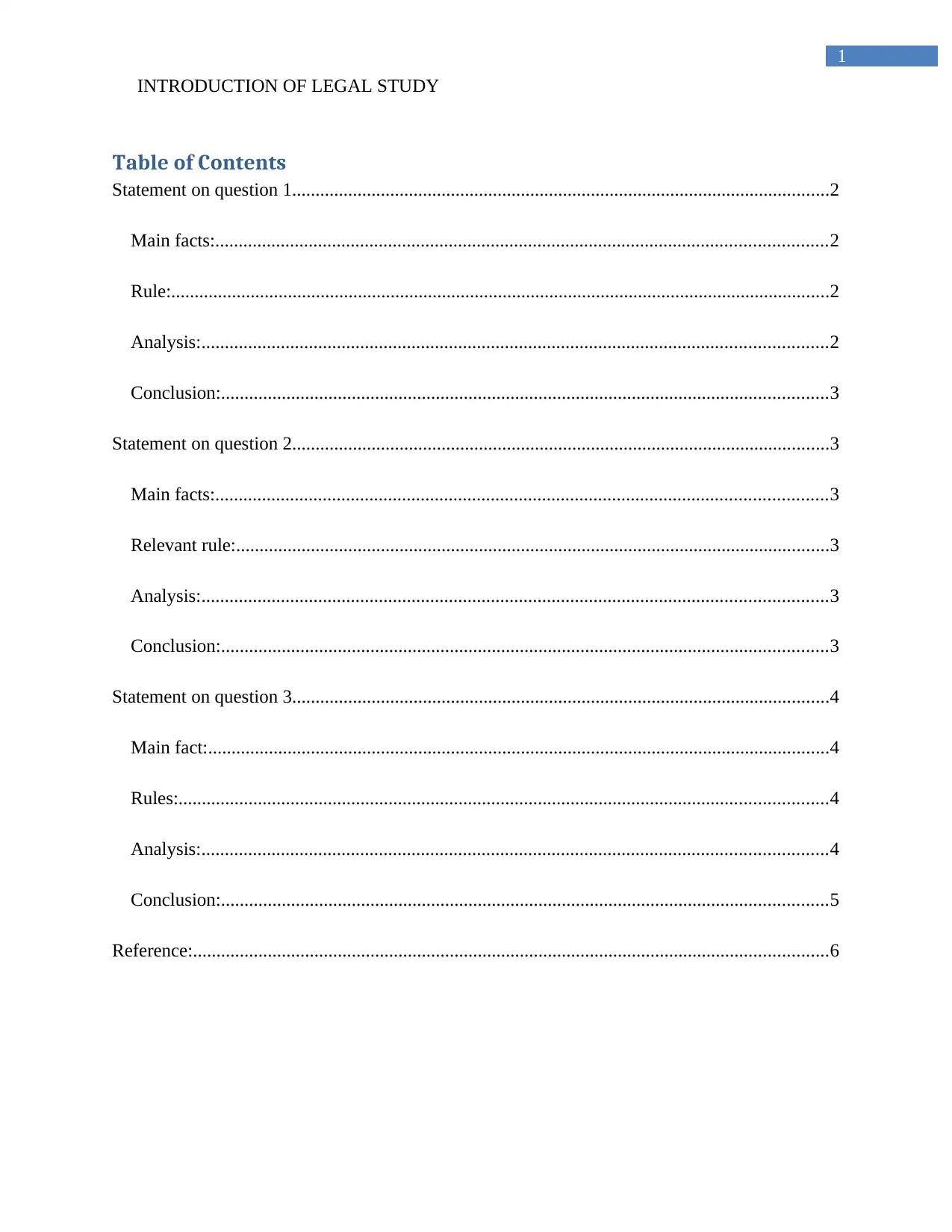
1
INTRODUCTION OF LEGAL STUDY
Table of Contents
Statement on question 1...................................................................................................................2
Main facts:...................................................................................................................................2
Rule:.............................................................................................................................................2
Analysis:......................................................................................................................................2
Conclusion:..................................................................................................................................3
Statement on question 2...................................................................................................................3
Main facts:...................................................................................................................................3
Relevant rule:...............................................................................................................................3
Analysis:......................................................................................................................................3
Conclusion:..................................................................................................................................3
Statement on question 3...................................................................................................................4
Main fact:.....................................................................................................................................4
Rules:...........................................................................................................................................4
Analysis:......................................................................................................................................4
Conclusion:..................................................................................................................................5
Reference:........................................................................................................................................6
INTRODUCTION OF LEGAL STUDY
Table of Contents
Statement on question 1...................................................................................................................2
Main facts:...................................................................................................................................2
Rule:.............................................................................................................................................2
Analysis:......................................................................................................................................2
Conclusion:..................................................................................................................................3
Statement on question 2...................................................................................................................3
Main facts:...................................................................................................................................3
Relevant rule:...............................................................................................................................3
Analysis:......................................................................................................................................3
Conclusion:..................................................................................................................................3
Statement on question 3...................................................................................................................4
Main fact:.....................................................................................................................................4
Rules:...........................................................................................................................................4
Analysis:......................................................................................................................................4
Conclusion:..................................................................................................................................5
Reference:........................................................................................................................................6
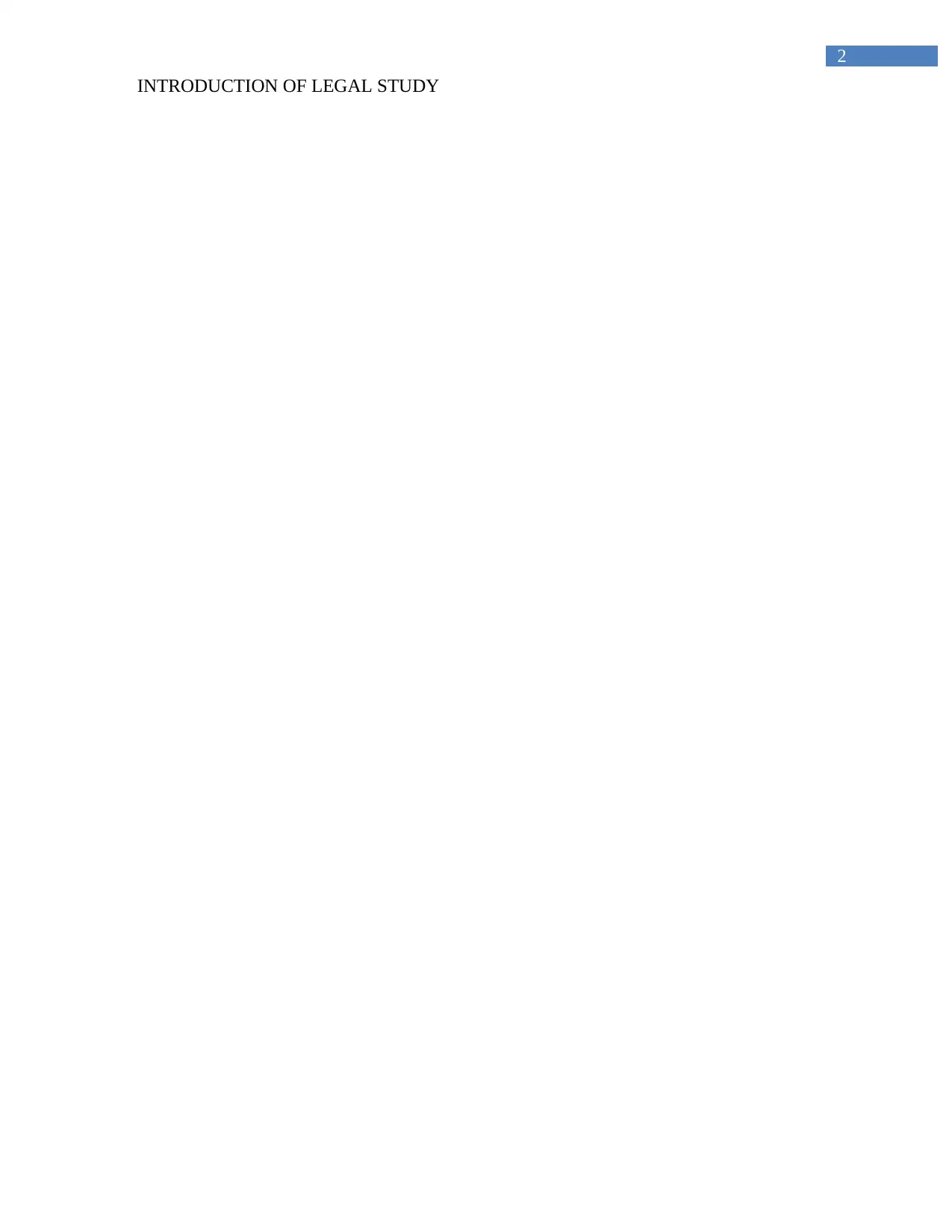
2
INTRODUCTION OF LEGAL STUDY
INTRODUCTION OF LEGAL STUDY
⊘ This is a preview!⊘
Do you want full access?
Subscribe today to unlock all pages.

Trusted by 1+ million students worldwide
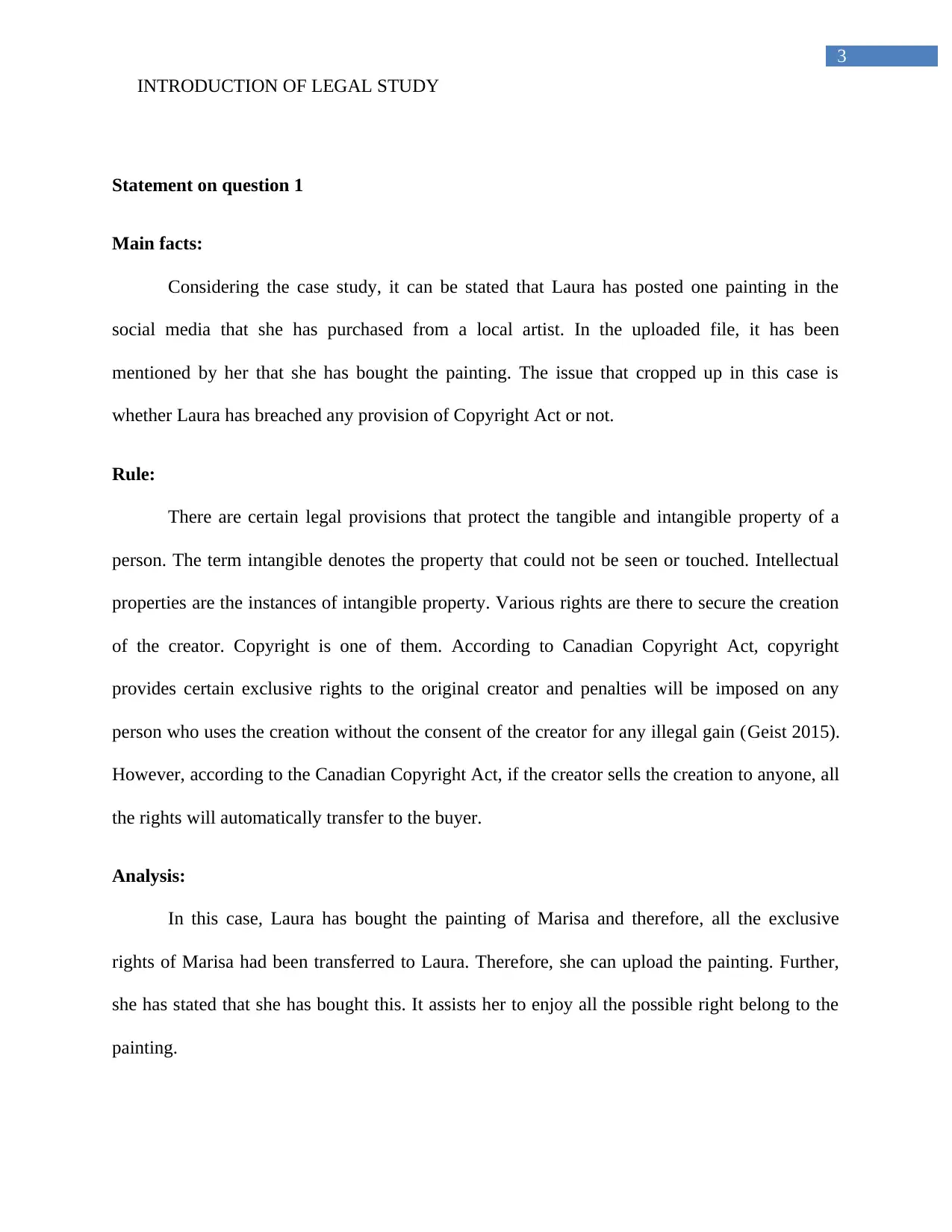
3
INTRODUCTION OF LEGAL STUDY
Statement on question 1
Main facts:
Considering the case study, it can be stated that Laura has posted one painting in the
social media that she has purchased from a local artist. In the uploaded file, it has been
mentioned by her that she has bought the painting. The issue that cropped up in this case is
whether Laura has breached any provision of Copyright Act or not.
Rule:
There are certain legal provisions that protect the tangible and intangible property of a
person. The term intangible denotes the property that could not be seen or touched. Intellectual
properties are the instances of intangible property. Various rights are there to secure the creation
of the creator. Copyright is one of them. According to Canadian Copyright Act, copyright
provides certain exclusive rights to the original creator and penalties will be imposed on any
person who uses the creation without the consent of the creator for any illegal gain (Geist 2015).
However, according to the Canadian Copyright Act, if the creator sells the creation to anyone, all
the rights will automatically transfer to the buyer.
Analysis:
In this case, Laura has bought the painting of Marisa and therefore, all the exclusive
rights of Marisa had been transferred to Laura. Therefore, she can upload the painting. Further,
she has stated that she has bought this. It assists her to enjoy all the possible right belong to the
painting.
INTRODUCTION OF LEGAL STUDY
Statement on question 1
Main facts:
Considering the case study, it can be stated that Laura has posted one painting in the
social media that she has purchased from a local artist. In the uploaded file, it has been
mentioned by her that she has bought the painting. The issue that cropped up in this case is
whether Laura has breached any provision of Copyright Act or not.
Rule:
There are certain legal provisions that protect the tangible and intangible property of a
person. The term intangible denotes the property that could not be seen or touched. Intellectual
properties are the instances of intangible property. Various rights are there to secure the creation
of the creator. Copyright is one of them. According to Canadian Copyright Act, copyright
provides certain exclusive rights to the original creator and penalties will be imposed on any
person who uses the creation without the consent of the creator for any illegal gain (Geist 2015).
However, according to the Canadian Copyright Act, if the creator sells the creation to anyone, all
the rights will automatically transfer to the buyer.
Analysis:
In this case, Laura has bought the painting of Marisa and therefore, all the exclusive
rights of Marisa had been transferred to Laura. Therefore, she can upload the painting. Further,
she has stated that she has bought this. It assists her to enjoy all the possible right belong to the
painting.
Paraphrase This Document
Need a fresh take? Get an instant paraphrase of this document with our AI Paraphraser
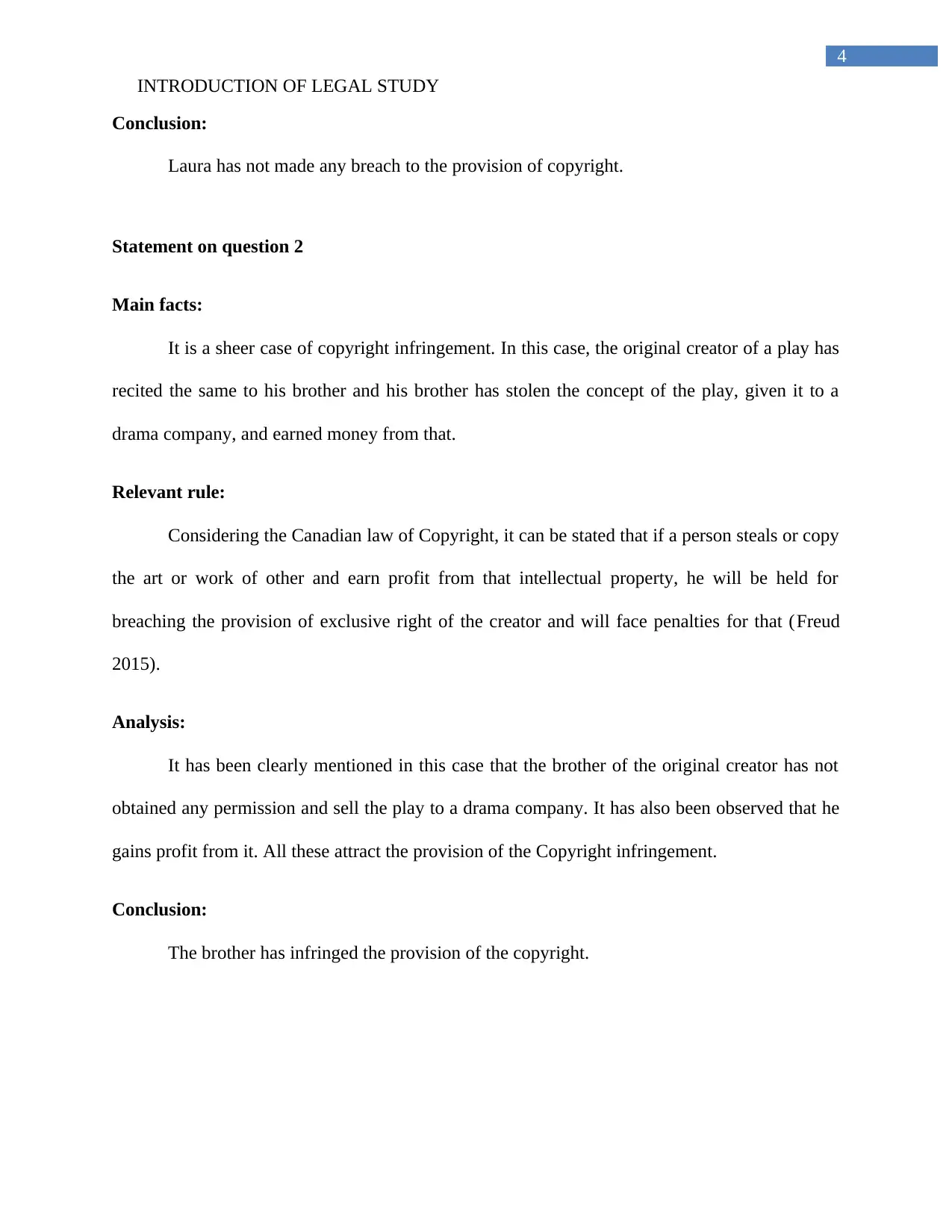
4
INTRODUCTION OF LEGAL STUDY
Conclusion:
Laura has not made any breach to the provision of copyright.
Statement on question 2
Main facts:
It is a sheer case of copyright infringement. In this case, the original creator of a play has
recited the same to his brother and his brother has stolen the concept of the play, given it to a
drama company, and earned money from that.
Relevant rule:
Considering the Canadian law of Copyright, it can be stated that if a person steals or copy
the art or work of other and earn profit from that intellectual property, he will be held for
breaching the provision of exclusive right of the creator and will face penalties for that (Freud
2015).
Analysis:
It has been clearly mentioned in this case that the brother of the original creator has not
obtained any permission and sell the play to a drama company. It has also been observed that he
gains profit from it. All these attract the provision of the Copyright infringement.
Conclusion:
The brother has infringed the provision of the copyright.
INTRODUCTION OF LEGAL STUDY
Conclusion:
Laura has not made any breach to the provision of copyright.
Statement on question 2
Main facts:
It is a sheer case of copyright infringement. In this case, the original creator of a play has
recited the same to his brother and his brother has stolen the concept of the play, given it to a
drama company, and earned money from that.
Relevant rule:
Considering the Canadian law of Copyright, it can be stated that if a person steals or copy
the art or work of other and earn profit from that intellectual property, he will be held for
breaching the provision of exclusive right of the creator and will face penalties for that (Freud
2015).
Analysis:
It has been clearly mentioned in this case that the brother of the original creator has not
obtained any permission and sell the play to a drama company. It has also been observed that he
gains profit from it. All these attract the provision of the Copyright infringement.
Conclusion:
The brother has infringed the provision of the copyright.
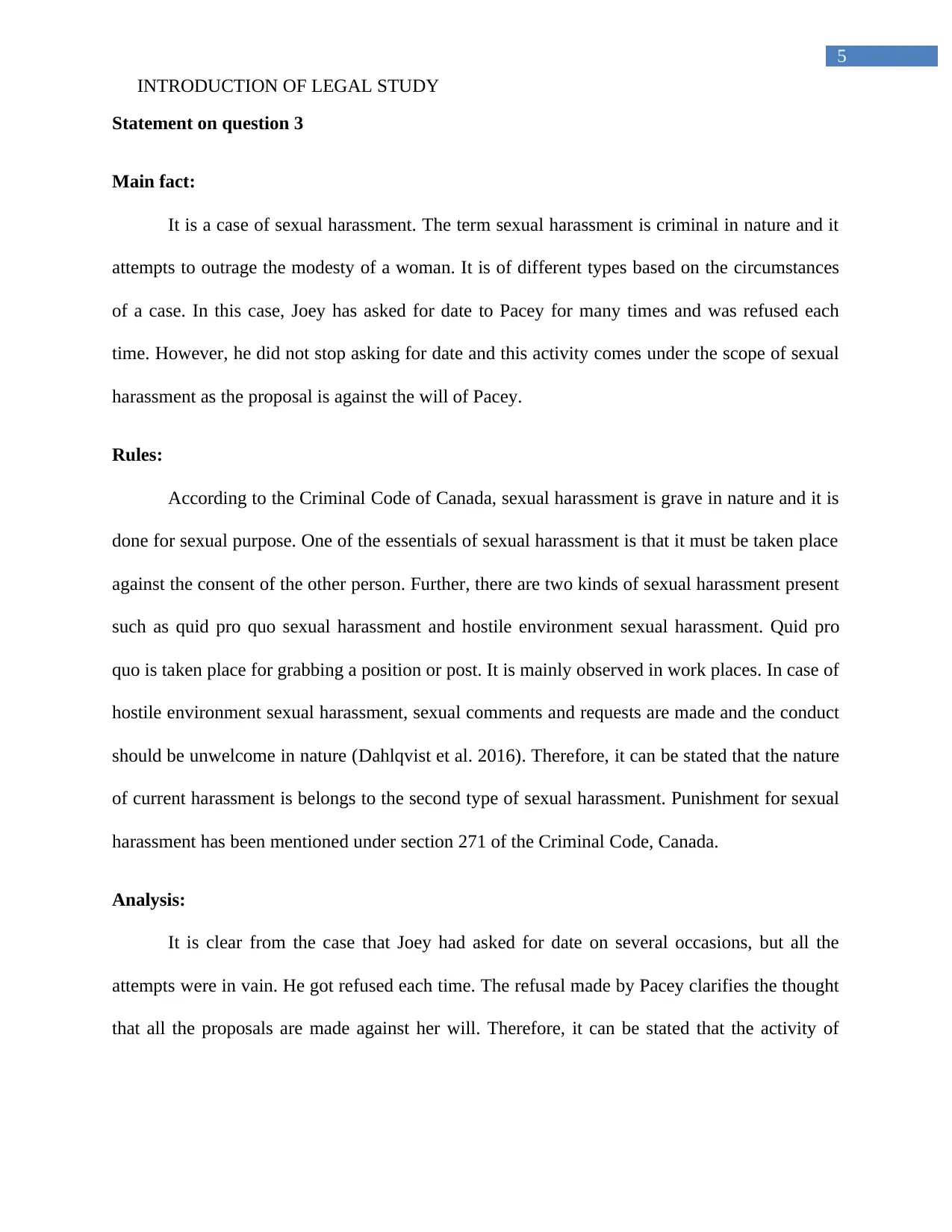
5
INTRODUCTION OF LEGAL STUDY
Statement on question 3
Main fact:
It is a case of sexual harassment. The term sexual harassment is criminal in nature and it
attempts to outrage the modesty of a woman. It is of different types based on the circumstances
of a case. In this case, Joey has asked for date to Pacey for many times and was refused each
time. However, he did not stop asking for date and this activity comes under the scope of sexual
harassment as the proposal is against the will of Pacey.
Rules:
According to the Criminal Code of Canada, sexual harassment is grave in nature and it is
done for sexual purpose. One of the essentials of sexual harassment is that it must be taken place
against the consent of the other person. Further, there are two kinds of sexual harassment present
such as quid pro quo sexual harassment and hostile environment sexual harassment. Quid pro
quo is taken place for grabbing a position or post. It is mainly observed in work places. In case of
hostile environment sexual harassment, sexual comments and requests are made and the conduct
should be unwelcome in nature (Dahlqvist et al. 2016). Therefore, it can be stated that the nature
of current harassment is belongs to the second type of sexual harassment. Punishment for sexual
harassment has been mentioned under section 271 of the Criminal Code, Canada.
Analysis:
It is clear from the case that Joey had asked for date on several occasions, but all the
attempts were in vain. He got refused each time. The refusal made by Pacey clarifies the thought
that all the proposals are made against her will. Therefore, it can be stated that the activity of
INTRODUCTION OF LEGAL STUDY
Statement on question 3
Main fact:
It is a case of sexual harassment. The term sexual harassment is criminal in nature and it
attempts to outrage the modesty of a woman. It is of different types based on the circumstances
of a case. In this case, Joey has asked for date to Pacey for many times and was refused each
time. However, he did not stop asking for date and this activity comes under the scope of sexual
harassment as the proposal is against the will of Pacey.
Rules:
According to the Criminal Code of Canada, sexual harassment is grave in nature and it is
done for sexual purpose. One of the essentials of sexual harassment is that it must be taken place
against the consent of the other person. Further, there are two kinds of sexual harassment present
such as quid pro quo sexual harassment and hostile environment sexual harassment. Quid pro
quo is taken place for grabbing a position or post. It is mainly observed in work places. In case of
hostile environment sexual harassment, sexual comments and requests are made and the conduct
should be unwelcome in nature (Dahlqvist et al. 2016). Therefore, it can be stated that the nature
of current harassment is belongs to the second type of sexual harassment. Punishment for sexual
harassment has been mentioned under section 271 of the Criminal Code, Canada.
Analysis:
It is clear from the case that Joey had asked for date on several occasions, but all the
attempts were in vain. He got refused each time. The refusal made by Pacey clarifies the thought
that all the proposals are made against her will. Therefore, it can be stated that the activity of
⊘ This is a preview!⊘
Do you want full access?
Subscribe today to unlock all pages.

Trusted by 1+ million students worldwide
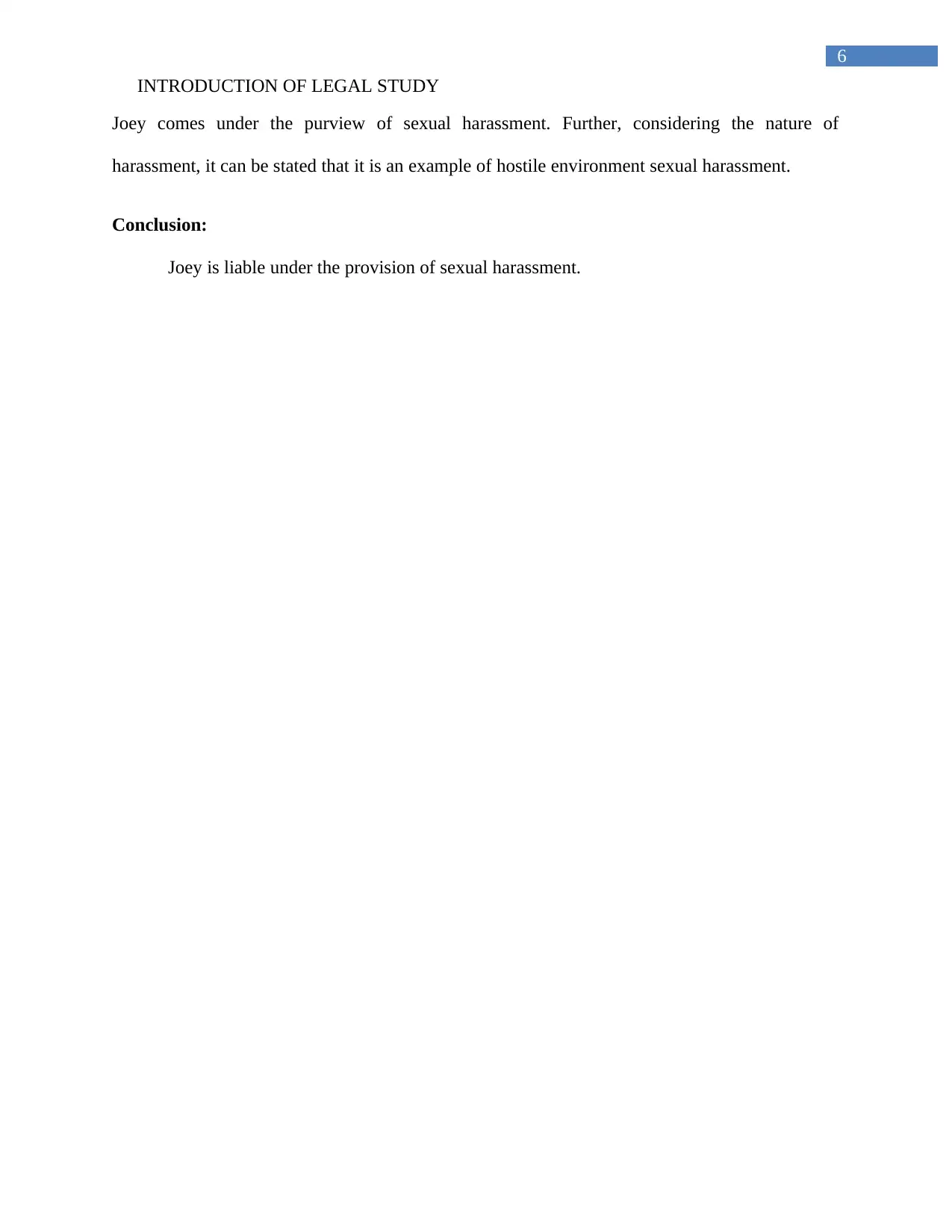
6
INTRODUCTION OF LEGAL STUDY
Joey comes under the purview of sexual harassment. Further, considering the nature of
harassment, it can be stated that it is an example of hostile environment sexual harassment.
Conclusion:
Joey is liable under the provision of sexual harassment.
INTRODUCTION OF LEGAL STUDY
Joey comes under the purview of sexual harassment. Further, considering the nature of
harassment, it can be stated that it is an example of hostile environment sexual harassment.
Conclusion:
Joey is liable under the provision of sexual harassment.
Paraphrase This Document
Need a fresh take? Get an instant paraphrase of this document with our AI Paraphraser
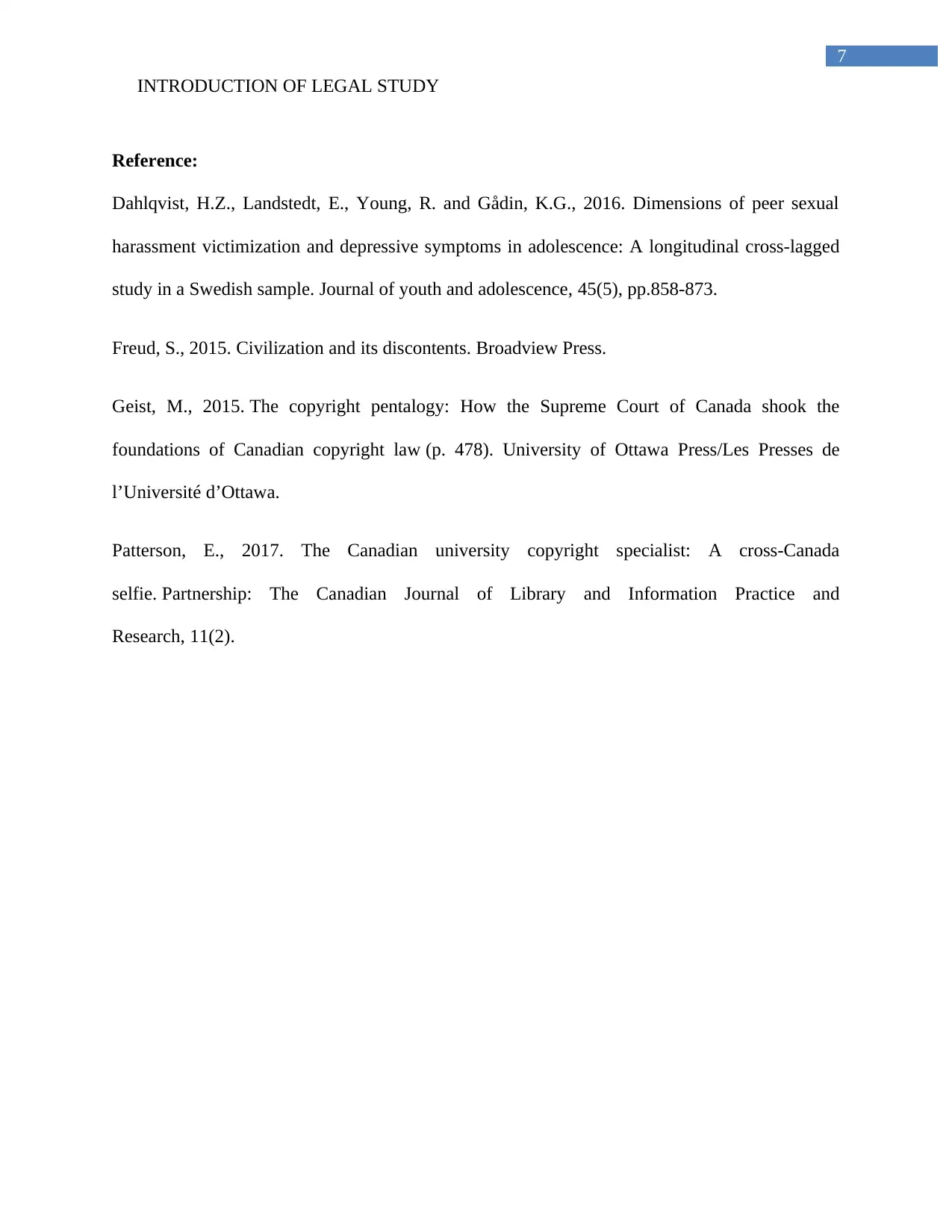
7
INTRODUCTION OF LEGAL STUDY
Reference:
Dahlqvist, H.Z., Landstedt, E., Young, R. and Gådin, K.G., 2016. Dimensions of peer sexual
harassment victimization and depressive symptoms in adolescence: A longitudinal cross-lagged
study in a Swedish sample. Journal of youth and adolescence, 45(5), pp.858-873.
Freud, S., 2015. Civilization and its discontents. Broadview Press.
Geist, M., 2015. The copyright pentalogy: How the Supreme Court of Canada shook the
foundations of Canadian copyright law (p. 478). University of Ottawa Press/Les Presses de
l’Université d’Ottawa.
Patterson, E., 2017. The Canadian university copyright specialist: A cross-Canada
selfie. Partnership: The Canadian Journal of Library and Information Practice and
Research, 11(2).
INTRODUCTION OF LEGAL STUDY
Reference:
Dahlqvist, H.Z., Landstedt, E., Young, R. and Gådin, K.G., 2016. Dimensions of peer sexual
harassment victimization and depressive symptoms in adolescence: A longitudinal cross-lagged
study in a Swedish sample. Journal of youth and adolescence, 45(5), pp.858-873.
Freud, S., 2015. Civilization and its discontents. Broadview Press.
Geist, M., 2015. The copyright pentalogy: How the Supreme Court of Canada shook the
foundations of Canadian copyright law (p. 478). University of Ottawa Press/Les Presses de
l’Université d’Ottawa.
Patterson, E., 2017. The Canadian university copyright specialist: A cross-Canada
selfie. Partnership: The Canadian Journal of Library and Information Practice and
Research, 11(2).
1 out of 8
Related Documents
Your All-in-One AI-Powered Toolkit for Academic Success.
+13062052269
info@desklib.com
Available 24*7 on WhatsApp / Email
![[object Object]](/_next/static/media/star-bottom.7253800d.svg)
Unlock your academic potential
Copyright © 2020–2025 A2Z Services. All Rights Reserved. Developed and managed by ZUCOL.





